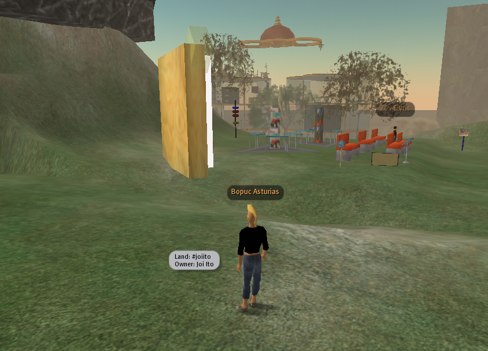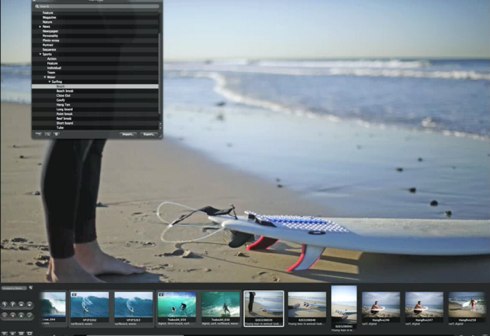About a week ago I went for chinese food with Michael. We hadn't seen each other in a few weeks and Mike had just returned from what seemed like a very exciting trip to Europe. He recounted parts of his trip and his recent move, and once we had finished, the carbo-coma kept us in our seats. As I poured us some more tea, I said to him: "so, I've been thinking about this thing lately... the Immersive Web."
Disclaimer: I am fully aware that there are loads of people who have been thinking about this stuff for a long time, who naturally know waaaay more than I do, etc etc. And while I've taunted Joi about his recent World of Warcraft "research", I trust implicitly that he knows what he's doing and doing it for good reasons. (No seriously. But I just had to link that PotatoChopped picture ;)
In a nutshell, what I mean by Immersive Web, is the combination of everything we know about 3D, virtual reality, networked "video games" and Open Source software projects, Open Standards, interoperability, accessibility, "self publishing", sharing and the whole kit-and-kaboodle linked with URLs.
Michael got really really excited and made it very clear that he definitely thought this was a very very important topic and one he had been thinking about for a long time. I knew he had some involvement with the 3D/games stuff through GameCode, but didn't realize it was something he held so close. Sometimes stuff goes over my head... or... in one ear and out the other... ;) I should also add that Michael's web-handle is mtl3p: "Montreal third place".
Fast forward to this afternoon: I am sitting in the conference room at the Berkman Center for Internet and Society, at the tail end of a Fellows meeting and the topic slowly shifts to "virtual worlds like Second Life and such". Some words fly out of my mouth, some hand gestures are made, some glances are thrown and all of a sudden I have volunteered Ethan and myself to write a 2 page paper on how/why Berkman should get involved in online virtual spaces, or something like that. Wahoo!
I shoot an email to Michael telling him such. Thirty minutes later he replies: "wow." "Goes fast doesn't it" I send back. A few minutes later my phone rings and it's him of course. "So, you at home? Whatcha doing?" "Dude, I'm at Berkman..."
Hehehehe. Then something funny happened, and I did something I haven't told him I did yet. Michael starts explaining why he thinks that my naming it "Immersive Web" is very very important. He is VERY excited as he is explaining this to me... so I switch my phone to speaker mode, letting Ethan listen in. ;)
Now, Michael does a really great job of explaining the socio-politcal and cultural ramifications of all this stuff and the naming, but I also needed to express an actual scenario of how I see an end product of "Immersive Web".
It came to me in two pieces; the first on the way to dinner, talking with Ethan, and the second walking back to the hotel after dinner, talking with Rebecca.
First of all, it should be relatively easy for me to upload and setup my own little "virtual place" on a server somewhere, the same way I can upload and install a weblog today. It shouldn't matter which "vendor" or "package" or "distribution" I choose, it should be able to be part of the greater community; the same way it doesn't matter, as Rebecca correctly pointed out, if I use Movable Type, WordPress, TypePad or Blogger to blog: I can still publish HTML and various RSS feeds, leave comments and have comments left for me, be aggregated and searched and most importantly, I can link and be linked to (that's what the Web *IS*).
Ethan pulled at the logic and we arrived at the question: "ok so what do we do with this?" 3D chat avatars are hold hat. Yawn, been there done that, right?
I emailed a scenario of use to Michael stating thusly:
"Let's say I want to share with you what it's like to stand at Hachiko Square in Shibuya, Tokyo. In a full featured and flexible immersive web environment, I could pull together various "media" from my personal archive and construct a very personal view/experience, pulling together perhaps a Google Earth/Map type of geo visualization, stitch in a bunch of photos I may have taken, a few other people have taken (pulled in dynamically via RSS feeds of tags from Flickr for example, and made available to me), play a recording I may have taken while there (or one someone else took and that I pulled down off the web, perhaps CC licensed?)... Imagine I could actually go and grab a premade virtual wireframe framework of that whole area, and "pin on" it my memories to share with you ... and whoever I gave the URL to it to."
(I should rewrite that to make it less redundant and to the point... it was stream of consciousness...)
Ethan pointed out : "but I can do that on a webpage now!" Yes and no. You can assemble all the bits and pieces but until you stitch them into an "environment", a situated and explorable "space", they remain just fragments, barely held together with some sort of narrative context which depends on the storyteller's story telling ability.
(Granted, very few people can create stunning 3D environments in even the simplest 3D CAD or game authoring system, but give any child a glue gun, a marker, some materials and a wall or four and watch the world he/she creates for you! Also, not every weblog is a impeccably designed masterpiece... most are straight default templates with a photo here and there...)
I also threw in:
"Two things that gave weblogs traction were: "simple" webpage making (post an entry and the webpage is "made for you") and the fact that the created "page" had a unique URI (a "permalink").
The first steps of Immersive Web is about laying the groundwork and making the infrastructure decisions which will eventually allows us "simple" "3D environment making" and giving it a URL..."
Another aspect that Michael is very keen on driving home is the fact that we have learnt over the last 10 years how to manage large scale distributed development of open source software projects. (Need I say it? Linux? Amongst hundreds of thousands of examples...) This is key since 3D virtual stuff, networking protocols, communications standards, programming etc etc etc ... all the stuff we will need to do to make something like an Immersive Web happen will require alot of work by alot of people with a lot of different skill sets.
I think it can be done.
(I am hoping to spend a good amount of time at the USC Interactive Media Department this winter. When I mentioned all this to Scott Fisher, a pioneer in the field of immersive media, his answer was immediate: "sounds good! let's do it!" Awesome. :)


